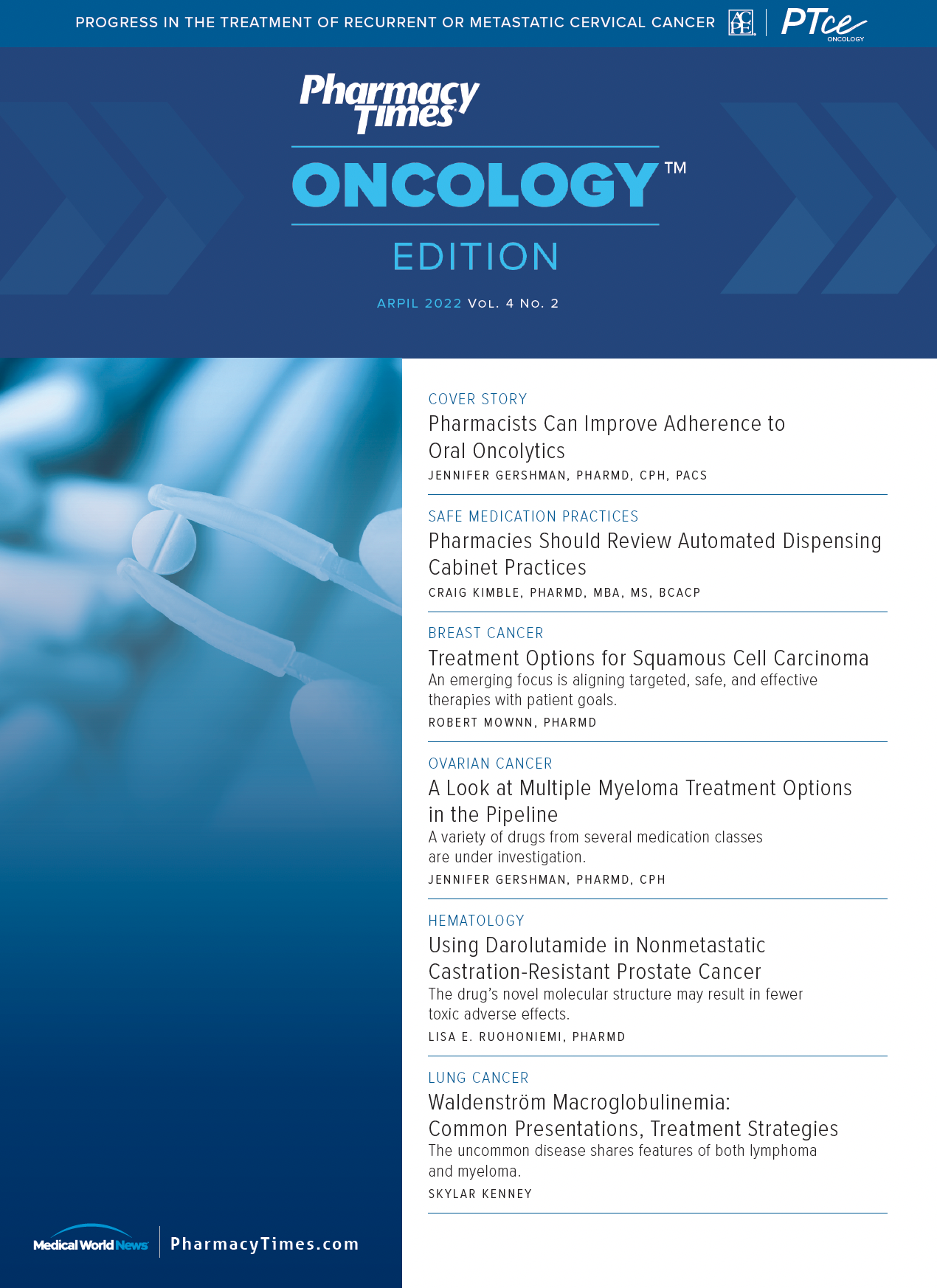Publication
Article
Pharmacy Practice in Focus: Oncology
An Overview of the Expanding Treatment Landscape of Chronic Myeloid Leukemia
Author(s):
Asciminib offers a new option for patients harboring the T315I mutation.
Chronic Myeloid Leukemia (CML) is a rare myeloproliferative disorder that accounts for approximately 15% of all leukemia cases, with approximately 9000 people projected to receive a diagnosis of the disease in the United States in 2022.1-4 CML is characterized by the translocation between the ABL1 gene on chromosome 9 and the BCR gene on chromosome 22, forming the constitutively activated BCR-ABL1 fusion gene, which is also known as the Philadelphia chromosome.1,2
Patients with CML are often asymptomatic at diagnosis, or they may present with constitutional symptoms, such as splenomegaly, along with anemia and elevated white blood cells and platelets.1,2 CML can be further classified into chronic phase (CP-CML), accelerated phase (AP-CML), or blast phase, but the large majority present with CP-CML.1,2,4
Currently, 6 FDA-approved oral tyrosine kinase inhibitors (TKIs) are available for the treatment of CML. With the introduction of BCR-ABL1 small molecule TKIs, patients with a CML diagnosis can expect a near-normal life expectancy. This scenario means an increased prevalence of CML will likely be a result in the United States, due to the increased number of survivors of the disease present in the country.1,2
As initial therapy for CP-CML, National Comprehensive Cancer Network guidelines recommend either the first-generation TKI imatinib (Gleevec; Novartis) or one of the second-generation agents: bosutinib (Bosulif; Pfizer), dasatinib (Sprycel; Bristol Myers Squibb), or nilotinib (Tasigna; Novartis).4 Additionally, the third-generation TKI ponatinib (Iclusig; Takeda) and the recently approved allosteric ABL1 inhibitor asciminib (Scemblix; Novartis) are options in later lines of therapy.4
Imatinib, dasatinib, nilotinib, bosutinib, and ponatinib all target the adenosine triphosphate binding pocket of BCR-ABL1, which leads to inhibition of BCR-ABL1 signaling.1,2 These agents differ in their BCR-ABL1 potency, toxicity profile, and dosing schedules. Despite a multitude of treatment options, patients may not tolerate treatment or may develop treatment resistance, such as in the case of the T315I mutation, which would necessitate the need for novel therapy options.1,5
Asciminib has a unique mechanism of action: As a STAMP (specifically targeting the ABL myristoyl pocket) inhibitor of BCR-ABL1, it allows for activity in patients with CML who have developed resistance or intolerance to prior therapies.5,6
Based on the results of the CABL001X2101 and ASCEMBL trials (NCT02081378 and NCT03106779), the FDA approved asciminib in October 2021 for patients with CP-CML who were previously treated with 2 or more TKIs, and for adult patients with CP-CML with the T315I mutation. The approval was granted under the accelerated approval process, with continued approval dependent upon longer follow-up.7
The CABL001X2101 clinical trial was a phase 1, multicenter, open-label, dose-escalation study that included 141 patients with CP-CML and 9 patients with AP-CML. Participants previously had an inadequate response or unacceptable adverse effects (AEs) from 2 or more BCR-ABL1 TKIs and were treated with asciminib either once or twice daily over a range of doses. Forty-five patients with CP-CML and the T315I mutation received asciminib at 200 mg twice daily. Nineteen of the 45, or 42%, achieved a major molecular response (MMR), defined as BCR-ABL1IS at less than or equal to 0.1%, at 24 weeks, and 22, or 49%, achieved it at 96 weeks. In a heavily treated population, including those with the T315I mutation, a maximum tolerated dose was not reached and treatment was well tolerated by those with disease activity.6,7
The ASCEMBL clinical trial was a multicenter, randomly assigned, phase 3 clinical trial in which 233 patients with CP-CML who experienced either intolerance or treatment failure after 2 or more TKIs were randomized in a 2:1 ratio to either asciminib 40 mg twice daily or bosutinib 500 mg daily. After a median follow-up of 14.9 months, 25.5% of patients in the asciminib group achieved an MMR vs 13.2% in the bosutinib group at 24 weeks.
In addition, at 24 weeks, 49% in the asciminib group had a BCR-ABL1IS less than or equal to 1% vs 23.7% in the bosutinib group. Grade 3 or higher AEs occurred in 50% of the asciminib group vs 60% of the bosutinib group. Finally, 5.8% of the asciminib group discontinued treatment because of toxicity vs 21.1% of patients in the bosutinib group.
The recommended asciminib dosing in CP-CML is 80 mg by mouth once daily or 40 mg by mouth twice daily. In patients with CP-CML with the T315I mutation, the recommended dose is 200 mg by mouth twice daily. Commonly reported AEs among patients include upper respiratory tract infections, musculoskeletal pain, fatigue, nausea, rash, and diarrhea. Common lab abnormalities include low blood counts and elevated cholesterol, pancreatic enzymes, creatinine kinase, and liver enzymes.7
Asciminib is an exciting new treatment option with a favorable AE profile in the third-line setting for patients with CP-CML, including those harboring the T315I mutation.
Jeremiah Moore, PharmD, BCOP, is a hematology/oncology clinical pharmacy specialist at the University of Rochester Medical Center in New York.
References
1. Jabbour E, Kantarjian H. Chronic myeloid leukemia: 2020 update on diagnosis, therapy and monitoring. Am J Hematol. 2020;95(6):691-709. doi:10.1002/ajh.25792
2. Osman AEG, Deininger MW. Chronic myeloid leukemia: modern therapies, current challenges and future directions. Blood Rev. 2021;49:100825. doi:10.1016/j. blre.2021.100825
3. Cancer stat facts: leukemia — chronic myeloid leukemia (CML). National Cancer Institute / Surveillance, Epidemiology, and End Results Program. Accessed February 3, 2022. https://seer.cancer.gov/statfacts/html/cmyl.html
4. NCCN. Clinical Practice Guidelines in Oncology. Chronic myeloid leukemia, version 3.2022. Accessed February 3, 2022. https://www.nccn.org/professionals/physician_gls/ pdf/cml.pdf
5. Réa D, Mauro MJ, Boquimpani C, et al. A phase 3, open-label, randomized study of asciminib, a STAMP inhibitor, vs bosutinib in CML after 2 or more prior TKIs. Blood. 2021;138(21):2031-2041. doi:10.1182/blood.2020009984
6. Hughes TP, Mauro MJ, Cortes JE, et al. Asciminib in chronic myeloid leukemia after ABL kinase inhibitor failure. N Engl J Med. 2019;381(24):2315-2326. doi:10.1056/ NEJMoa1902328
7. Scemblix. Prescribing information. Novartis; 2021. Accessed February 3, 2022. https://tinyurl.com/5epcyv83







